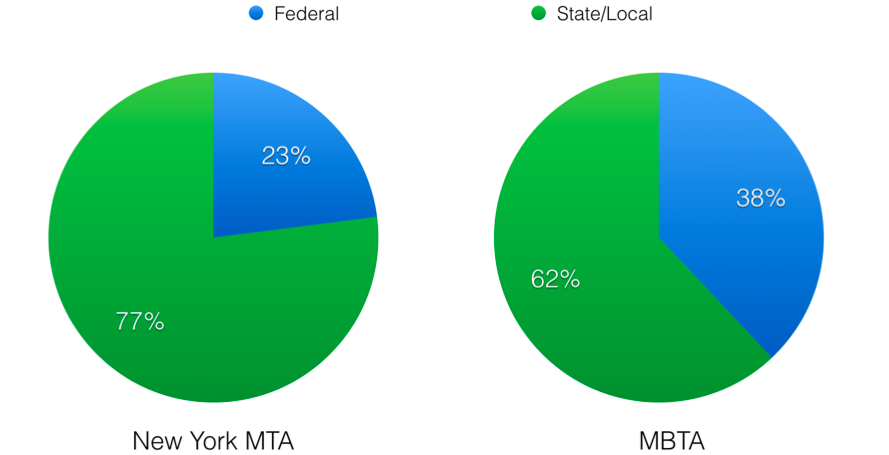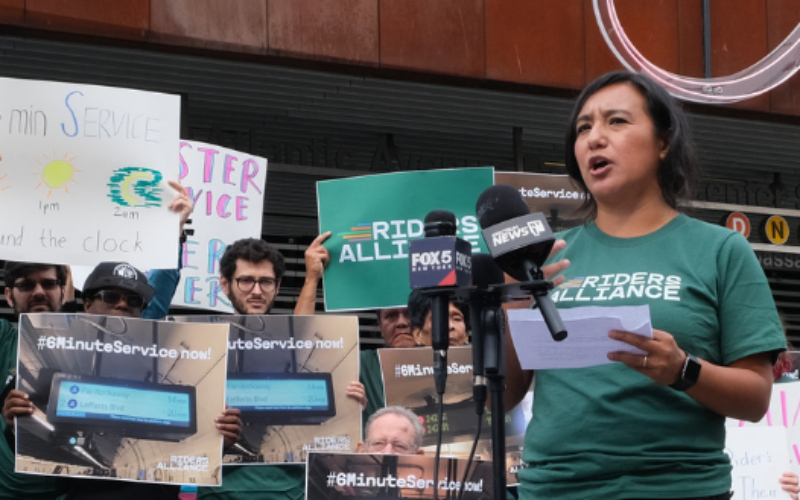

PHOTO CREDIT: MICHAEL SEMENSOHN. LICENSED UNDER CC BY-NC-ND 2.0.
A recent New York Times headline posed a question that has surely been on the minds of many East Coast commuters: Why are the venerable subway systems in Boston, New York, and Washington in such dire condition? Other than the usual calls for “more investment” that dominate reporting about America’s transportation infrastructure, however, the article didn’t provide a complete explanation as to why each transit system is falling short of expectations.
There is, in fact, no universal cause. The subway, the Metro, and the T face distinct challenges particular to their histories, funding structures, and governance. Rather than search in vain for a panacea, advocates and elected officials in each city must recognize that each transit system is uniquely troubled and address those issues accordingly.
New York: A Capacity Problem
The New York City Subway is in a somewhat enviable position among the three transit systems. While its infrastructure is aging (and, in some cases, literally crumbling), the system is in a good enough state of repair to offer New Yorkers frequent and fairly predictable service on a day-to-day basis.
The subway’s problem is that it’s too popular. Ridership has increased by 22 percent (or 500 million annual rides) since 2005, and the MTA is staggering under the challenge of providing sufficient capacity to meet ever-growing demand for mass transit. Notably, New York is one of the few places in the country where ridership growth is severely outpacing overall growth—the population of the five boroughs has increased just 4 percent in the same period of time.
While the MTA’s capital program and annual operating budgets generally provoke sustained political battles, New York has established mechanisms for bringing significant state and local resources to bear on the system’s basic infrastructure needs.
But to cope with the crush of riders, the MTA needs to focus on capacity, capacity, capacity. This means signal upgrades that allow more trains to run closer together, design improvements to the subway cars that eliminate wasted space, and new lines to populous parts of the city not currently well-served by transit. A more reliable bus system, which constitutes a substantial piece of the transit network that is slowly failing, would also go a long way toward improving the quality of New York’s transit service. (Bus usage in New York has fallen by more than 130 million annual rides since 2006.)
Boston: A Funding Problem
In Boston, the MBTA is unquestionably under-resourced to a woeful degree—a fact that was made plain by the city’s horrifically snowy winter of 2014-2015. By one measure recently noted on The Connection—capital expenditures per track-mile—America’s oldest subway system is significantly behind most of its peers.
Often overlooked, though, is the significant extent to which the source of the MBTA’s capital funding differs from other major transit agencies.
The Boston area devotes proportionately far less state and local funding to transit than New York does. As a result, the MBTA relies to an unusual extent on federal funds—both formula-based and discretionary—to maintain and expand its infrastructure. The New York MTA’s 2015 to 2019 $29.4 billion capital program is projected to contain 23 percent federal funds. The MBTA’s $6.2 billion capital investment program, which covers the same five years, is 38 percent federally funded. Put another way, if Boston held the amount of federal funding constant but increased state and local funding to the same proportion as in New York, the MBTA’s capital plan would grow by more than $3 billion.
A Tale of Two Capital Plans

This discrepancy has been true in the recent past as well. According to the National Transit Database, 54 percent of the MBTA’s 2014 capital spending came from federal sources versus 41 percent for MTA New York City Transit. Boston’s figure was the highest in the country among transit agencies that operate heavy-rail subway systems.
This dependence on federal funding is a problem on multiple fronts. First, it puts the MBTA’s financial health largely in the hands of politicians and USDOT officials who have no particular stake in the quality of Boston’s public transportation. Second, even assuming those people’s intentions are good, most of Washington’s funding for transit comes from the Highway Trust Fund, which is in perpetual peril due to Congress’s unwillingness to raise the federal gas tax.
The good news in Boston is that there seems to be a large community of riders who are willing to rely on the system if the MBTA invests in it. Ridership since the snow-related transit shutdown has mostly rebounded, and Boston is one of the few large American cities that has actually seen an increase in bus ridership in the years since the recession.
Washington: A Management Problem
Washington, like the other systems, could clearly do more with more funding, but re-establishing stable and competent governance is WMATA’s most pressing issue. While CEO Paul Wiedefeld is addressing repair of the most critical elements of Metro’s rail infrastructure—and has taken the salutary step of firing 20 senior and middle managers—reforming the agency’s deeply corroded, dysfunctional work and management culture will take additional time, concerted attention, and more new blood. U.S. Transportation Secretary Anthony Foxx slammed the agency again in May for continued problems with its attention to safety issues.
WMATA’s governance structure needs work at higher levels as well. While the agency has established a five-year capital program cycle, the stream of funding from the states, the federal government, and the District of Columbia has never been (and was never intended to be) guaranteed over the long term. This design leads to difficulty planning large-scale investments and allows each jurisdiction to wield undue leverage over minor issues. Moreover, the ability to keep WMATA on a short leash does not conversely mean these jurisdictions are always responsive when WMATA is in a time of need. Although the federal government assumed safety oversight of Metro in October 2015, the multiparty agreement needed to establish a new WMATA safety oversight board has taken more than eight months to be drafted and is still not formally in place.
Wiedefeld is managing WMATA’s turnaround with the express confidence of nearly every important governmental stakeholder. Metro’s riders, though, are another question. With rail ridership down 11 percent since 2008 and bus ridership down 5 percent, WMATA may be facing a long-term crisis of confidence in the entire transit system.
 On the Brink: Will WMATA’s Progress Be Erased by 2024?
On the Brink: Will WMATA’s Progress Be Erased by 2024?
The experience of being a WMATA rider has substantially improved over the last 18 months, thanks to changes the agency has made like adding off-peak service and simplifying fares. Things are about to get even better with the launch of all-door boarding later this fall, overnight bus service on some lines starting in December, and an ambitious plan to redesign the Metrobus network. But all of this could go away by July 1, 2024.
Read More Built to Win: Riders Alliance Campaign Secures Funding for More Frequent Subway Service
Built to Win: Riders Alliance Campaign Secures Funding for More Frequent Subway Service
Thanks to Riders' Alliance successful #6MinuteService campaign, New York City subway riders will enjoy more frequent service on nights and weekends, starting this summer. In this post, we chronicle the group's winning strategies and tactics.
Read More